London, England
London provides the backdrop for many Disney films. In the 1961 animated version of “One Hundred and One Dalmatians,” the leading duo of Pongo and Perdita first meet in Regent’s Park, where a twist of fate (and leashes) sends their owners flopping into the pond. Fast forward to the 1996 live-action version, and the picturesque St. James’s Park, London’s oldest Royal Park, sets the stage. In both versions, the dogs embark on a comedic adventure through the city, passing many of London’s most famous attractions, such as the iconic Big Ben.
The streets of London have also witnessed the high-flying adventures of Peter Pan and Mary Poppins. When Peter Pan teaches the kids to fly, Big Ben’s minute hand is their landing spot before they soar across the London skyline en route to Neverland. In another Disney classic, Mary Poppins sings and dances all over London. When she sings “Feed the Birds,” she’s singing about a woman selling bird food from the steps of the iconic St. Paul’s Cathedral.
Ashdown Forest, England
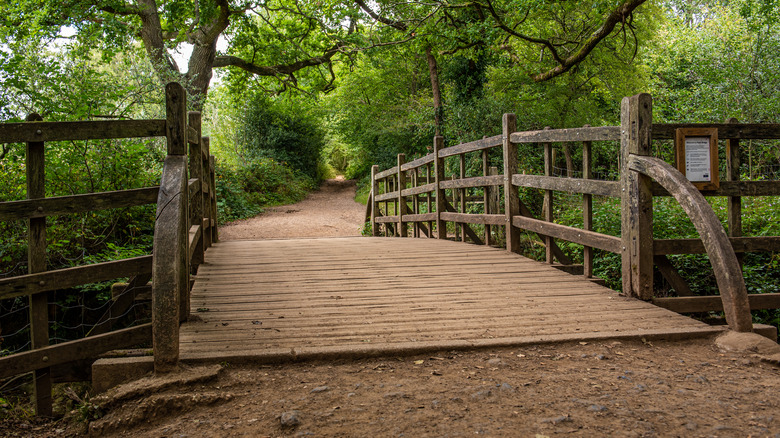
In the tales spun by A.A. Milne, Winnie-the-Pooh frolicked under the trees of the Hundred Acre Wood. This whimsical place was not purely the figment of Milne’s imagination! It was inspired by the real-life Ashdown Forest, near Milne’s home in Southern England. When prepping for the full-length “Winnie the Pooh” film in 2011, the filmmakers didn’t just Google it — they trekked to the forest for inspiration.
The Ashdown Forest Trust, stewards of this enchanted land, welcomes Disney fans from all over the world to explore the forest. Seek out the legendary Poohsticks Bridge or simply wander while pondering, “What would Tigger do?” Spread over 10 square miles, Ashdown Forest shelters critters that sound like they waltzed straight out of a fairy tale. Catch the serenade of the rare Dartford warbler or the nightjar, who flies all the way from Africa to breed in this storybook setting. And if you feel a tickle on your nose, it might just be the silver-studded blue butterfly, perhaps mistaking you for Pooh! Amble along walking paths, bask under trees, and enjoy far-reaching views of the world where Winnie-the-Pooh’s adventures began.
Calanais Standing Stones, Scotland
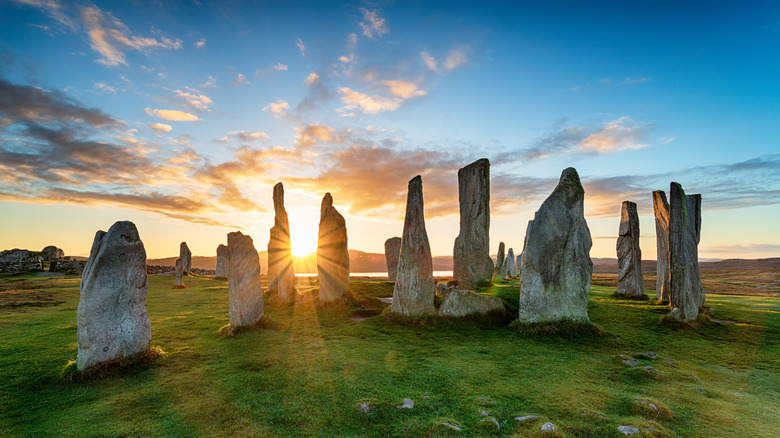
Helen Hotson/Shutterstock
Predating Stonehenge, the 5000-year-old Calanais Standing Stones in Scotland hold secrets that not even Merida, the fiery-haired heroine from “Brave,” could unravel. These stones inspired the vision for the magical stones Merida discovers on her journey. They stand on an island filled with archaeological and historic sites, waiting to tell their tales.
Much like Merida on her quest, the filmmakers ventured to the real-life stones. They encountered a mysterious circle of columns surrounding a towering monolith stretching over 15 feet tall. Why were these stones erected? Were they an ancient astronomical observatory? A place of ritual? Or maybe both?
Known to some as the Callanish Stones or Callanish I, a visit takes you beyond the majesty of the rocks. Surrounding the stones is the breathtaking backdrop of the Isle of Lewis, where rugged cliffs drop down to white sandy beaches.
Thankfully, you don’t need a bow, arrow, or a spell gone awry to enjoy these views. The Calanais Standing Stones welcome visitors year-round, with a visitor’s center full of information about the history of the site. So, ready your horse (or maybe just a comfortable pair of shoes) and venture to a place where Disney magic meets Scottish history.
Notre Dame Cathedral, France
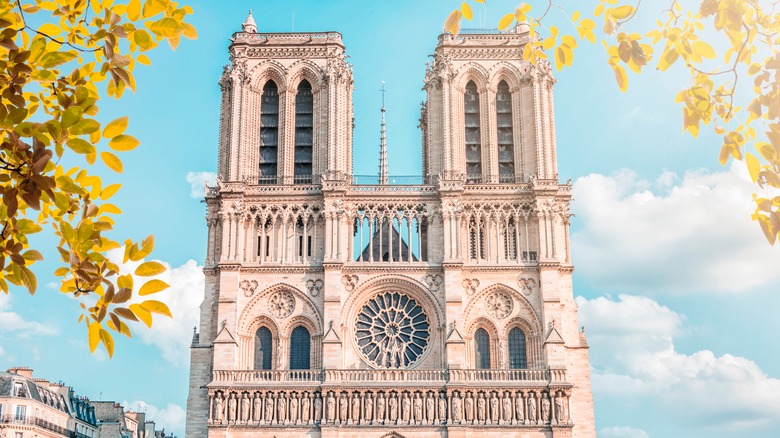
Stockbym/Shutterstock
Disney’s 1996 classic, “The Hunchback of Notre Dame,” stars Quasimodo, a bellringer with a heart bigger than the bells he rings. The actual cathedral might lack singing gargoyles, but one can easily glimpse the magic that breathed life into the enchanting movie. While a 2019 fire damaged the real Notre Dame, the cathedral’s spirit remains resilient.
Today, visitors can explore the public square, tour the cathedral, and peek into the progress at a nearby exhibit, “Notre-Dame de Paris: at the heart of the construction site.” And the bells remain ready! Even the fire couldn’t steal their song. They echoed loudly through the square when they were rung on the first anniversary of the blaze.
Before the 2019 fire, the cathedral was France’s most popular tourist attraction, receiving even more visitors than the Eiffel Tower. Original construction for Notre Dame began in 1163 and continued for the next two centuries. This masterpiece of Gothic elegance earned its UNESCO World Heritage title in 1991. In addition to its awe-inspiring architecture, the site houses sculptures, detailed carvings, paintings, and religious and historical artifacts. But the gargoyles (even if they aren’t singing) and the kaleidoscope play of stained-glass windows steal the show. Once Notre Dame reopens in December 2024, those with a Quasimodo-esque spirit might climb 387 steps up the bell tower to be rewarded with panoramic views of Paris.
Château de Chambord, France
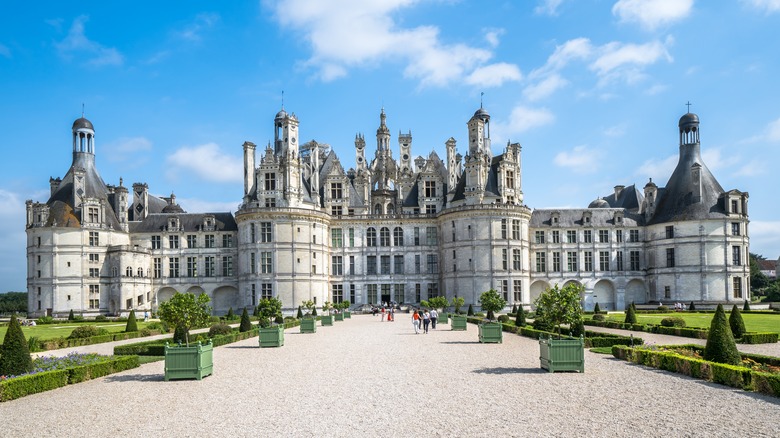
D.Bond/Shutterstock
If the castle in “Beauty and the Beast” seemed enchanting, imagine visiting the real-life castle that inspired it. Château de Chambord, in the Loire Valley of France, is a masterpiece of the Renaissance, featuring intricate moats, a forest of chimneys, and a double helix staircase, believed to be influenced by Leonardo da Vinci. A vast park and wildlife reserve surrounds the castle, with the château’s French formal gardens designed to seamlessly bridge the castle grounds to the forest beyond.
If you’re yearning to follow in Belle’s footsteps, Chambord invites you to be their guest year-round. Choose from a guided or self-guided tour to explore the chateau and gardens. Enjoy various activities, such as a horse and carriage show. Stroll along miles of footpaths through the surrounding park, making stops at numerous educational signs to learn about the surrounding history, flora, and fauna, or rent a bike and zip through the heart of the forest.
Alcázar de Segovia, Spain
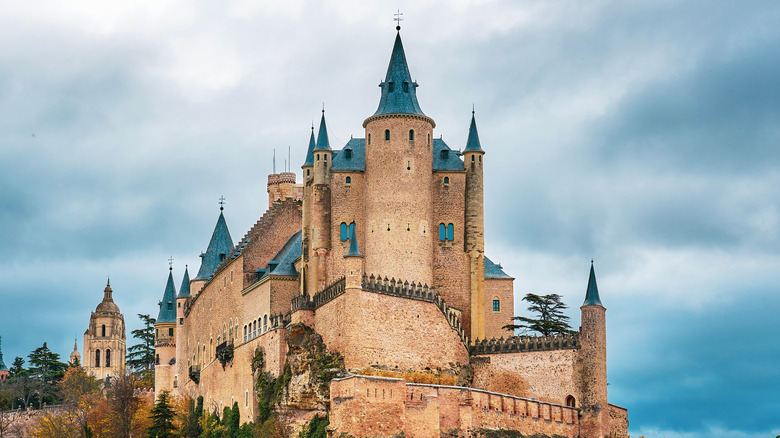
yalcins/Shutterstock
One of Spain’s most iconic landmarks, Alcázar of Segovia is a well-preserved medieval fortress fit for a princess and an evil queen. Standing majestically atop a rugged rock, its regal ship-bow form and fairytale turrets inspired the castle in “Snow White and the Seven Dwarfs” (1937). Overlooking the confluence of two rivers, the castle has been a fortress, a royal palace, a military academy, and even a prison — perhaps where they locked away people who used apples inappropriately.
For those eager to learn about Alcázar de Segovia’s secret passageways, consider a guided tour. Once inside, admire lavish interiors from the King’s Room to the Chapel. Somewhere, in one of these fancy rooms, there might even be a Magic Mirror. A rich collection of art, armor, and artifacts await in the castle’s museum, and if you can stand a dizzying climb up a spiral staircase in the Tower of Juan II, you’ll reach stunning views of the historic city of Segovia.
The Black Forest, Germany
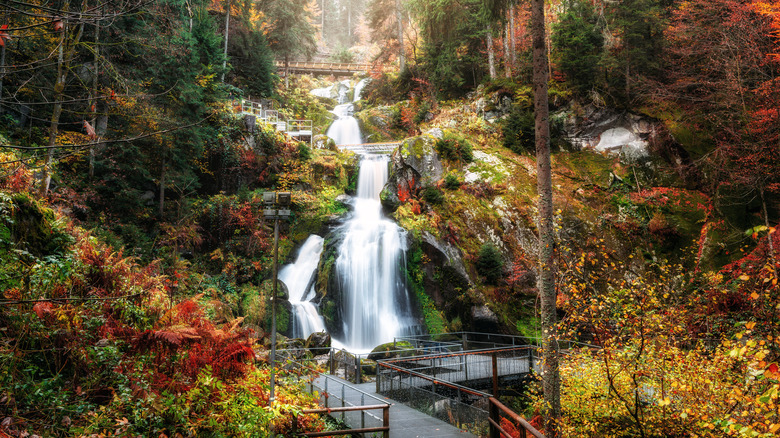
Andrii Zabolotnyi/Shutterstock
In “Snow White and the Seven Dwarfs,” the Huntsman gives Snow White some odd travel advice. “Run into the woods,” he insists, but these aren’t just any woods. Inspired by the Black Forest in southwest Germany, Snow White flees into a dark, windy chaos where tree branches look like gnarled hands trying to grab her. Shadows and noises play tricks on her. Creatures with scary eyes lurk around every corner. It’s not exactly a glowing review.
But hold onto your poisoned apples! The Black Forest isn’t just Snow White’s nightmare. It’s one of the most beautiful forests in the world. The forest is tucked away in Germany’s southwest, where summers are a hiker’s dream and winters are full of snowshoeing adventure. It is an area of quaint towns with timber-framed houses straight out of a fairytale pop-up book, the cascading waters of Germany’s tallest waterfall, and the lush green forests of a National Park.
Have your cake and eat it, too — the world-famous Black Forest cake is reason enough to make the trip. Dive into layers of chocolate, cherries, and whipped cream — definitely a perk Snow White missed out on. Sure, the forest casts spooky shadows as a thick canopy of evergreens blocks the sun, but remember, once Snow White woke up after that first haunting night, she found this place pulsating with song and dance as it transformed into a place filled with wonder and community.
Rothenburg ob der Tauber, Germany
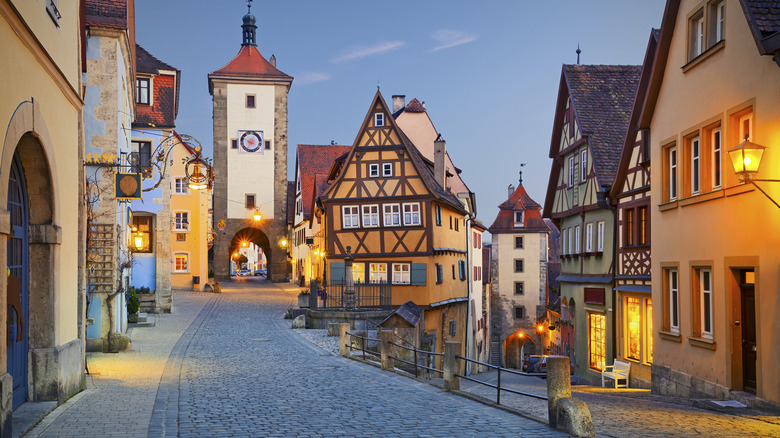
Rudybalasko/Getty Images
In the heart of Bavaria’s Franconia region, there’s a place where medieval town walls surround cobblestoned streets. If you listen closely, you might hear the faint notes of Pinocchio’s “When You Wish Upon a Star.” Welcome to Rothenburg ob der Tauber, a town so drenched in medieval charm that it seems to have emerged right out of Geppetto’s workshop.
Indeed, this town inspired the village in “Pinocchio” (1940). With 46 historical towers and well-preserved town walls, you must pass through one of its six regal gates or a pedestrian door to enter this magical world. Once inside, wander through Market Square, where one might half-expect to see Jiminy Cricket dancing near the fountain. The museums in Rothenburg range from the twinkling year-round Christmas Museum to the gripping tales of the Medieval Crime Museum. Stop at the town’s famous photo op, the Plönlein, where roads part ways around a half-timbered house.
But don’t feel confined to the city walls. Just outside, meander along paths in the Tauber Valley. A short walk takes you to St. Peter and Paul’s Church, which is over 1,000 years old. Enjoy its stunning architecture and beautiful setting alongside the Tauber River.
Akershus Fortress, Norway
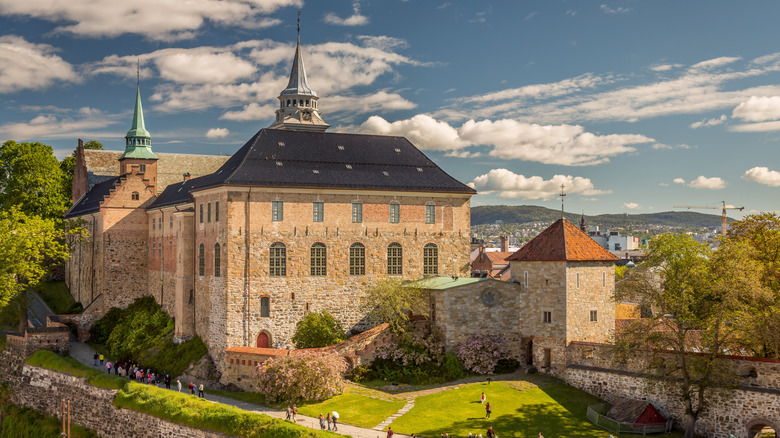
Paulo Miguel Costa/Shutterstock
Akershus Fortress and Akershus Castle inspired Disney’s “Frozen” (2013). The film crew visited the site, which overlooks Oslo’s harbor. The historic stone walls, majestic towers, and waterfront views gave rise to Anna and Elsa’s castle, and as you wander through the well-preserved medieval structures, you can imagine the movie’s ice castle materializing right before your eyes.
A fortress since the 13th century, Akershus has defended Oslo from sieges but has never been taken by force. Today, the fortress is a cultural hub, with onsite museums, restaurants, theater performances, and holiday celebrations lighting up the historic grounds. The Castle Church hosts concerts and is a favorite venue among chamber music performers. The Visitor Center in the Artillery shares information about the Fortress and Oslo in general. After delving into history, take a moment to relax in the serene castle grounds. Perhaps you’ll picture Anna and Elsa playing in the snow-covered courtyards; just try not to worry about Akershus Castle’s gloomy dungeons.
Blyde River Canyon Nature Reserve, South Africa
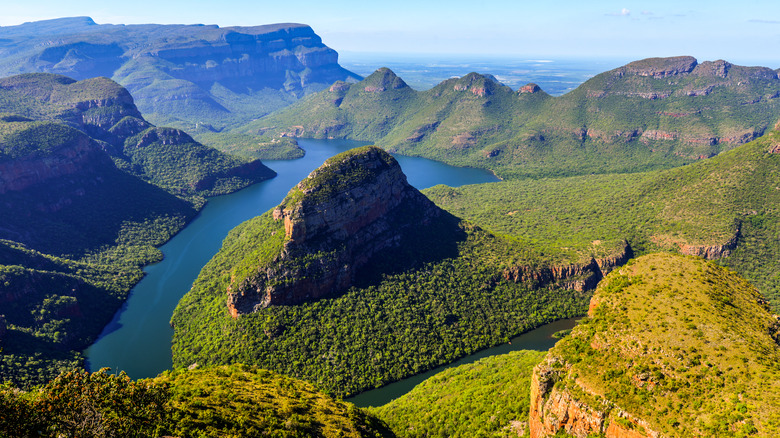
Demerzel21/Getty Images
Wakanda is a fictional place, but the filmmakers of “Black Panther” drew inspiration from various real-life locations. One location was the Blyde River Canyon Nature Reserve in South Africa, one of the world’s largest canyons. It stands out with its lush cloak of green foliage, which is why it’s known as the largest ‘green canyon.’ Contrasting with the green forests, towering rock formations command attention. Meanwhile, the meandering Blyde River runs through the canyon, which stretches over 16 miles in length.
Viewpoints like God’s Window live up to their celestial names. Many visitors drive along Route 532, which travels along the canyon’s western edge. Viewpoints along the route invite you to pull over and enjoy the area’s natural beauty. If time and interests permit, the canyon has a lot more to offer beyond its immense beauty, including outdoor recreation. Prep for hiking, hop on a bike, saddle up for horseback riding, or dive into exhilarating water sports. You’ll almost certainly enjoy your time here — the name “Blyde River” is of Dutch origin, meaning “happy river.”
Reynisfjara Black Sand Beach, Iceland
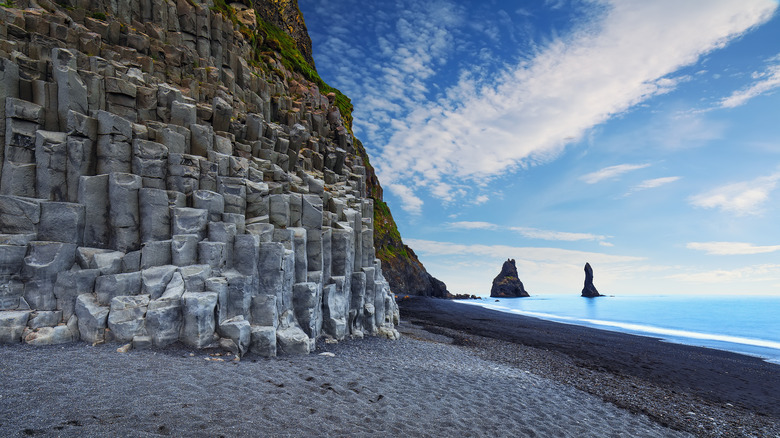
Vadym Lavra/Shutterstock
In a galaxy not so far away, nestled in the heart of Iceland, lies the dramatic Reynisfjara Black Sand Beach — where reality and the fictional world of Star Wars collide. The captivating alienesque landscape of this beach didn’t escape the eyes of the “Rogue One: A Star Wars Story” (2016) filmmakers. Though it looks like another planet, this cinematic gem is a mere 2.5-hour hyperdrive (or, you know, drive) from Iceland’s capital.
Reynisfjara is not a wear-your-sandals and bask-in-the-sun type of beach, as hiking boots are better than sandals for the trail down. The Icelandic chill grips the coast throughout the year, but with the proper attire, the scenery is worth the trip. Bring out your inner birdwatcher and spot seabirds, including adorable puffins, nesting on the cliffs. Hypothesize about the imposing basalt columns — local folklore has it that these pillars are frozen trolls, though each Icelander you ask might offer a different story.
Tread carefully during low tide, and you might find yourself at the mouth of Hálsanefshellir Cave. But a word of warning: While the force might be strong with you, do respect the power of the beach’s sneaker waves. Always be alert, as you wouldn’t want to be unexpectedly transported to a location far, far away.
Olympus National Park, Greece
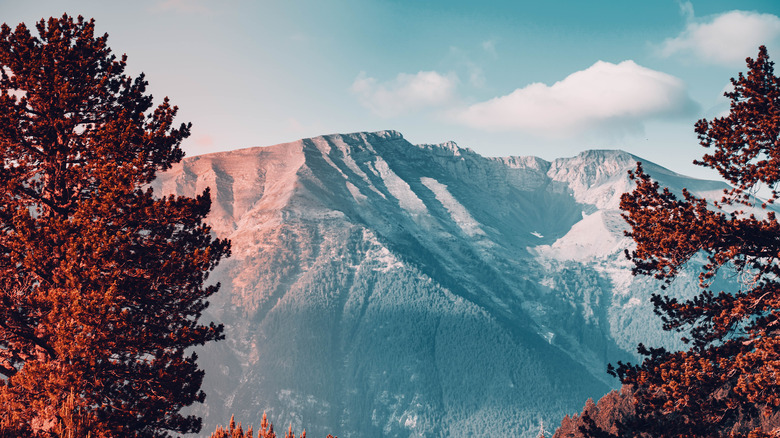
Georgios Andritsos/Shutterstock
In the animated world of “Hercules” (1997), the son of Zeus wants to be a hero and join the Greek gods on Mount Olympus. Worthy of the park’s name, Mount Olympus pierces the clouds as Greece’s highest mountain, and its tallest peak, Mytikas, reaches 9,573 feet. Also known as Pantheon, Mytikas is believed to be the meeting place of the gods. Imagine standing where Zeus might have unleashed his fury, as the northern side of the Olympus range bears thunderstorms 12 times more often than the rest of Greece.
Olympus National Park is a hiker’s paradise, with routes ranging from gentle strolls to heroic treks. Navigate deep gorges, wander through forests, visit high-altitude plateaus, and marvel at cascading waterfalls. As you journey, the park rolls out the green carpet with over 1,700 plant species. Listen for various bird calls, from eagles to woodpeckers, spot wild goats, and see why the park is a hotspot for butterflies, with hundreds of different species within the park. It’s no wonder Mount Olympus inspired Disney’s “Hercules.” Why just watch the legends when you can walk among them?
The Great Barrier Reef, Australia
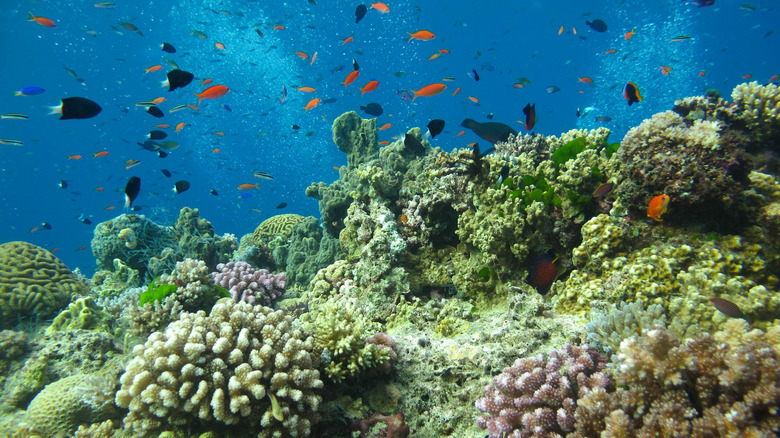
Paula Jones/Getty Images
See if you can find Nemo, or at least a Nemo-like fish, in Australia’s Great Barrier Reef. Along Australia’s eastern coastline, you can swim among 1,600 fish species. If you’re lucky, you may spot a clownfish that reminds you of our little orange hero or find a blue tang fish reminiscent of the friendly and forgetful Dory. But this reef is much more than just fish tales. Skies echo the calls of hundreds of bird species, and over 600 vibrant types of coral paint the ocean floor. Thousands of mollusk species make their home here, as do turtles catching currents, just like in the movie. Do you remember loving the vibrant backdrops in “Finding Nemo”? Australia’s Great Barrier Reef, one of the most beautiful coral reefs in the world, was the muse!
To dive into Nemo’s world, splash down at hotspots like Cairns or the Whitsundays Islands. The warm, clear waters and eclectic marine life make the area a popular snorkel and diving destination. If you prefer to stay dry, you can still peep into the deep blue through glass-bottom boats. The islands also offer great restaurants, markets, and some of the world’s best beaches.
Oaxaca, Mexico
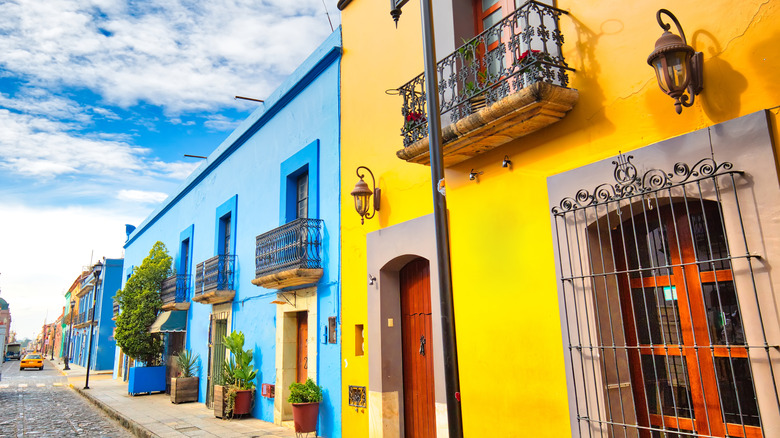
eskystudio/Shutterstock
When Disney embarked on creating “Coco” (2017), an animated celebration of Mexico’s Dia de los Muertos (Day of the Dead), authenticity was key. The filmmakers took multiple trips to Oaxaca, Mexico, to study the locations and people who inspired the movie, meeting the inspiration for Miguel’s Abuela along the way. They visited a shoemaker and his workshop and participated in the art of making papel picado, a traditional Mexican paper craft. They saw Monte Albán, an archaeological and historical site in Oaxaca, which served as inspiration for the land of the ancestors in “Coco.” And they even met a real-life Xolo dog!
Oaxaca seamlessly blends timeless charm and modern flair with many historic churches, bohemian bars, traditional markets, and contemporary street art. With so much to offer, it’s no wonder Oaxaca is frequently ranked as one of the world’s top cities, and its pleasant climate means it is a great place to visit any time of the year.
Valle de Cocora, Colombia
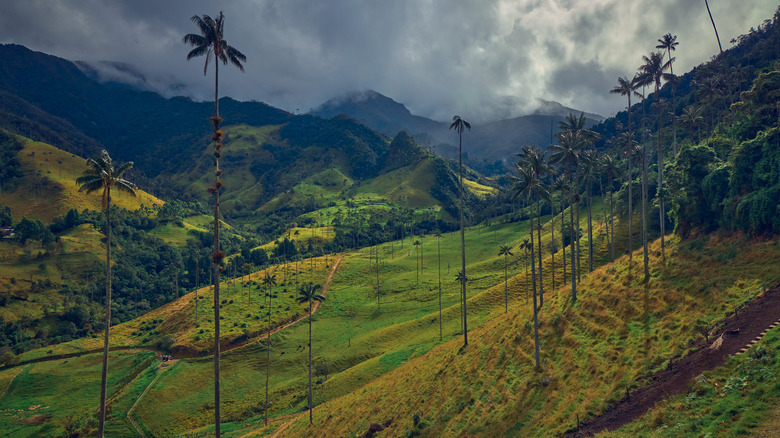
Jmichaelmedia/Getty Images
Imagine stepping into the vibrant world of “Encanto” (2021). The directors didn’t have to imagine. When they saw the breathtaking Valle de Cocora in Colombia, they knew they had found the setting for the movie. Surrounded by mountains and nestled in Colombia’s coffee heartland, the lush green slopes of Cocora showcase the country’s thrilling biodiversity.
Endemic wax palms, Colombia’s national tree, tower into the sky, reaching heights of nearly 200 feet, as tall as a 20-story building! While you’re working skyward, watch out for the massive Andean condor, the national bird of Colombia. Though you won’t likely spot it, the area is also home to the endemic and critically endangered Yellow-eared parrot, but you’ll have a much better chance of spotting hummingbirds and toucans.
Getting to this location worthy of Disney magic is an adventure in and of itself. Most people take Jeep taxis on a bumpy road from nearby Salento. Once the Jeeps have taken you as far as they can, hiking and horseback riding are great ways to explore the village.

